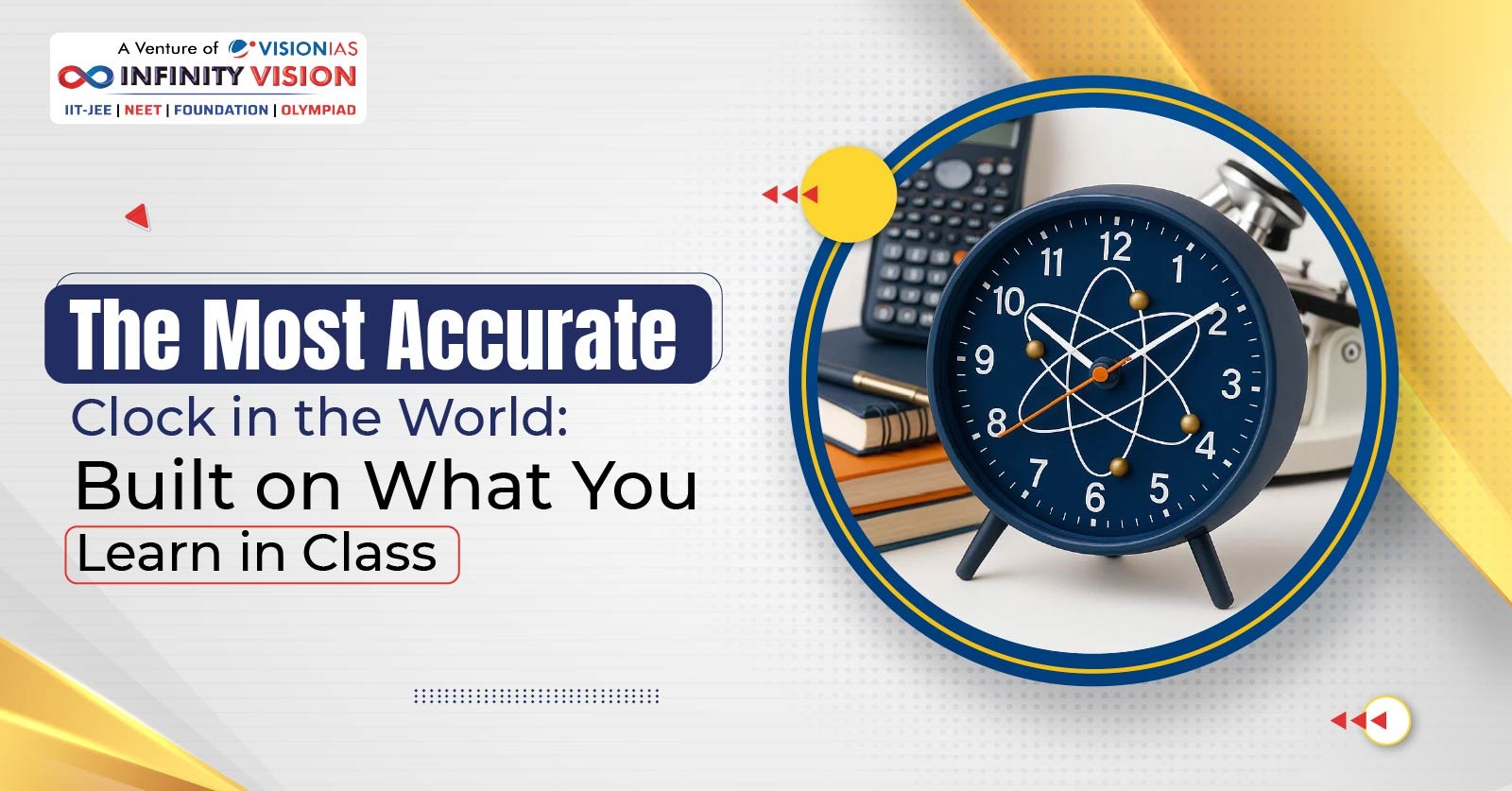What if we told you there’s a clock so accurate that it won’t gain or lose even a single second for over 30 billion years? Scientists at the National Institute of Standards and Technology (NIST) in the United States have recently developed the most precise atomic clock ever. This isn’t just a record-breaking invention; it’s a practical use of concepts you already learn in school: atoms, energy levels, frequency, and time. This major achievement shows how what we learn in the classroom can lead to discoveries that change our understanding of the universe.
The objective of this blog is to inspire young scientific minds in India by decoding the science behind the world’s most accurate clock. So keep reading if you want to know more about it.
What Makes an Atomic Clock So Precise?
In high school, you learn that atoms have electrons that move between fixed energy levels. Are you able to recall that? When electrons jump from one level to another, they absorb or emit energy as electromagnetic radiation. These transitions happen at specific and consistent frequencies.
Well, this is also the basic idea behind an atomic clock. Instead of using mechanical gears or a quartz crystal, atomic clocks rely on the regular “ticks” of atoms, which come from the vibrations caused by electron transitions, to measure time. Because these atomic vibrations are very stable, they provide outstanding accuracy.
What’s So Special About NIST’s Most Accurate Atomic Clock?
The most accurate atomic clock developed at NIST uses a single aluminium ion (Al⁺) as the timekeeping element. Aluminium is known for its frequency stability, but it is very hard to observe directly. To address this, scientists used a helper ion, magnesium. The magnesium ion assists in cooling and reading the aluminium ion’s state without interfering with its performance. This method is called quantum logic spectroscopy.
What sets this clock apart:
- A more stable laser system is used to probe the atom’s frequency.
- A redesigned ion trap reduces atomic motion and outside interference.
A cleaner and more controlled environment improves measurement stability.
All these innovations together have made the clock around 40 per cent more accurate than previous models.
How Accurate Are We Talking?
To grasp how precise this clock is, consider this: if it had started running at the moment the universe began (around 13.8 billion years ago), it would now be off by less than one second.
Its uncertainty is just 8.6 parts in 10¹⁹. That means the variation in its timekeeping is unimaginably small, making it the most accurate clock ever built.
What is the Importance of This in Real Life?
The development of atomic clocks is not only useful in laboratories or space organisations. It has numerous impacts on real-world technology and science.
1. GPS and Navigation
GPS systems depend on precise time measurements. Even a billionth-of-a-second error can cause location errors of several meters. More accurate clocks mean more precise navigation, from smartphones to aeroplanes.
2. Gravity and Einstein’s Relativity
According to Einstein’s general relativity, time moves more slowly in stronger gravitational fields. This new, most accurate atomic clock is so sensitive that it can detect time differences caused by a height change of just one centimetre. Such tiny effects are now measurable in real-time.
3. Reconceptualising the Second
The modern definition of the second is founded on the vibrations of a caesium-133 atom at microwave frequencies. The new aluminium-ion clock is much more stable and runs at optical frequencies. In the future, it can redefine what a second measures.
4. Powering the Future
Advanced technologies such as quantum computing and exploration of deep space require very precise timekeeping. This clock has the potential to make such complex systems more efficient and reliable.
How This Links to Your School Science
Here’s how the science you study is directly connected to this invention:
- Atomic Structure (Class 11): Electron transitions in atoms, which form the basis of atomic clocks.
- Emission Spectra (Class 12 Chemistry): Each element emits radiation at a unique frequency, which is used as a reference in these clocks.
- Frequency and Time (Physics): The definition of time in physics is based on how frequently something occurs.
- Measurement Systems (Units): The definition of the second itself is based on atomic properties, a topic covered in school.
Real Progress Starts with School-Level Science
This new atomic clock is not just a scientific instrument. It is a powerful reminder that the concepts taught in school form the foundation for world-changing discoveries.
The lessons in your NCERT textbooks are not just theory. They are tools to understand and eventually shape the future.
When you learn about atoms, energy levels, and frequency, you are stepping into the same world that scientists use to build the most accurate clock in history. Science is not about memorising facts. It is about understanding how the universe works and using that understanding to push the boundaries of what’s possible.
Meanwhile, are you aware about the fact that the Earth isn’t just a planet, it also functions like a giant magnet due to its molten iron core. Learn more about Earth’s magnetic field here, and do visit our page regularly for such amazing scientific highlights.











